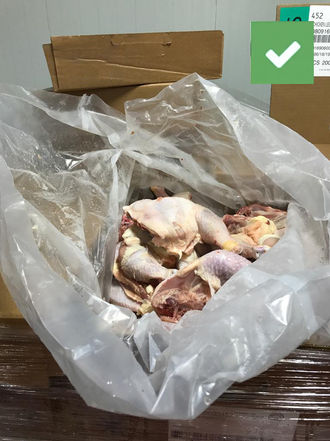Phase02
Packaging
-
Primary Packaging: It is the container used to contain a product and which is in contact with it. The primary packaging must weigh less than 35 Kg.
-
Secondary Packaging: It is the container used to contain the primary packaging.
-
Combo: It is a cubic or cylindrical-shape container made of cardboard, plastic or another safe material usually larger than a box. In the case of cardboard material, it shall be lined with plastic to prevent meat from attaching. If the product is presented in bulk, it does not weigh more than 50 kg.
-
Packaging material: They are all materials, procedures and methods used to condition, present, handle, store, preserve and ship goods.
Meat products shall be shipped and stored in optimum conditions for its due preservation and innocuousness throughout the logistics chain, from the plant to its final destination. Therefore, physical presentation, layout, packaging, package and materials used to this end, are of great importance to prevent any inconvenience at the time of entering Mexico.
It is necessary to understand clearly how to submit before the authorities in Mexico the goods for importation, since at the time of animal health inspection and customs review, the irregularities, particularly when it comes to critical defects, might not be amended.
Meat products shall be shipped at the right temperature according to the type of goods and its state (fresh-chilled or frozen). Therefore, it is key to have compact, good-quality packaging which holds well under moist conditions.
Usually, a cardboard package is more commonly used for these goods, taking into account that it is 100% recyclable. Truly durable cardboard products can be composted and thus be naturally recycled.
High resistance to moisture makes compact cardboard to be suitable for storage and shipping of goods chilled or frozen. In contact with exudative moisture, cardboard usually keeps its structure without softening, which makes goods to preserve quality and innocuousness.
Usually, layout and packaging of meat products takes place in different manners:
-
For wholesale or foodservice, goods are to be wrapped in plastic or polyethylene bags to prevent moisture loss, and the plastic bag is to be put inside a cardboard box or combo. Boxes or combos are to be sealed, strapped with adhesive tape and the label adhered on the outside with fully-identifying information according to NOM-030-ZOO- 1995 Mexican Standard. The box strength shall be capable to withstand the stacking height without being deformed, and the label shall have sufficiently resistant glue so as not to peel off.
-
In case of goods for direct sale to end consumers or at retail, the goods are to be wrapped in several plastic or polyethylene bags or packages to prevent moisture loss in individual presentations. Those bags are to be put in a cardboard box. Boxes or combos are sealed and strapped with adhesive tape. In this case, each individual bag or package shall have the label with all necessary information to enter Mexico in accordance to NOM-051- SCFI/SSA1-2010 Mexican Standard. The box strength shall be capable to withstand the stacking height without being deformed, and the label shall have glue sufficiently resistant so as not to peel off.
Goods shall not be contained in primary packages which are contained in secondary packaging and which do not allow for verification of labeling for each primary package. Ideally, they are to be contained in a primary package which allows for the proper identification of the product and labeling.
It is important to use pallets or stacked products which facilitates loading and unloading of goods. If pallets are made of debarked wood, they shall bear the official stamp indicating they were subjected to treatment against pests using methyl-bromide fumigation (MB) with a total 24-hour exposure, heat treatment (HT) or heat treatment by dielectric heating (DH) in accordance to NOM-144-SEMARNAT-2017 Mexican Standard –which sets forth the phytosanitary measures to reduce the risk of introduction and/or spreading of quarantine pests associated to international trade mobilization of wood packaging material, made of raw wood used in international trade).
Refer to regulations on International Trade Wood Packaging Material:
http://www.fao.org/3/a-mb160e.pdf
NOM-144-SEMARNAT-2017:
https://www.dof.gob.mx/nota_detalle.php?codigo=5514060&fecha=22/02/2018
- Examples of correct or incorrect loads:
Stamp to be borne by wooden pallets or boards:



The ISO code for the US is “US”










